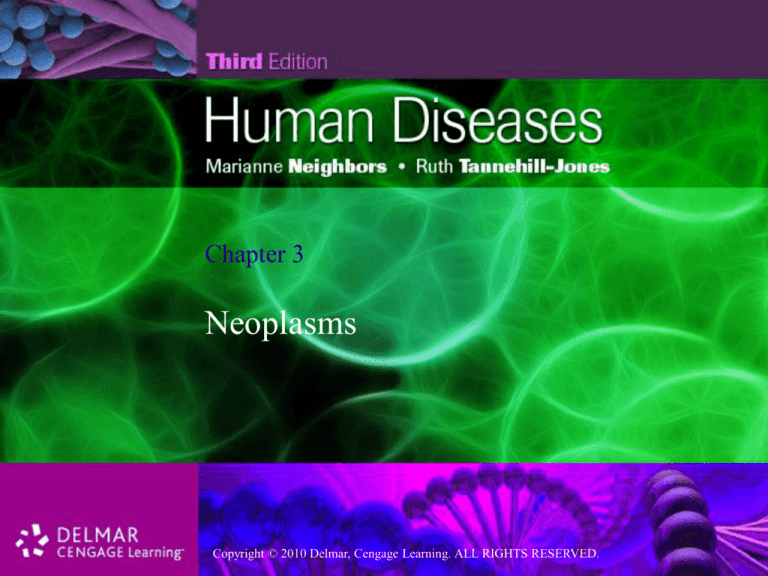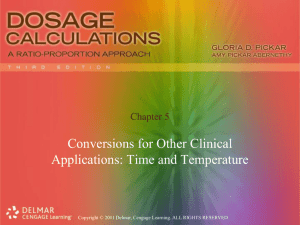
Chapter 3
Neoplasms
Copyright
Copyright
© 2010
© 2010
Delmar,
Delmar,
Cengage
Cengage
Learning.
Learning.
ALLALL
RIGHTS
RIGHTS
RESERVED.
RESERVED.
Terminology of Neoplasms and
Tumors
• Neoplasm
– New growth
• Tumor
– Swelling or neoplasm
Copyright © 2010 Delmar, Cengage Learning. ALL RIGHTS RESERVED.
Terminology of Neoplasms and
Tumors
• Leukemia
– Malignant disease of bone marrow
• Hematoma
– Bruise or contusion
Copyright © 2010 Delmar, Cengage Learning. ALL RIGHTS RESERVED.
Hematoma
Copyright © 2010 Delmar, Cengage Learning. ALL RIGHTS RESERVED.
Classification of Neoplasms
• Cancer
– General term for malignant tumor or neoplasm
• Classified according to:
– Appearance and growth pattern
– Type of body tissue from which they arise
Copyright © 2010 Delmar, Cengage Learning. ALL RIGHTS RESERVED.
Classification of Neoplasms
Copyright © 2010 Delmar, Cengage Learning. ALL RIGHTS RESERVED.
Classification of Neoplasms
• Tumors:
– Benign
• Confined to local area
– Malignant
• Spreads to other areas
– Carcinoma
• Largest group of malignancy
Copyright © 2010 Delmar, Cengage Learning. ALL RIGHTS RESERVED.
Classification of Neoplasms
• Tumors:
– Lymphoma
• Malignant neoplasms of blood-forming organs and lymphatic
tissues
– Sarcoma
• Neoplasms of connective tissue
Copyright © 2010 Delmar, Cengage Learning. ALL RIGHTS RESERVED.
Classification of Neoplasms
• Tumors:
– Melanoma
• Malignant neoplasm of melanocytes
– Glioma
• Tumors of glial cells of brain
Copyright © 2010 Delmar, Cengage Learning. ALL RIGHTS RESERVED.
Benign and Malignant Neoplasms
• Benign tumors
– Growth in particular area
• But not invasive or metastatic
– Encapsulated in capsule
– Easier to excise
– Limited growth potential
Copyright © 2010 Delmar, Cengage Learning. ALL RIGHTS RESERVED.
Benign and Malignant Neoplasms
• Malignant tumors
– Without structure or function of normal cells
– Surface area not encapsulated
Copyright © 2010 Delmar, Cengage Learning. ALL RIGHTS RESERVED.
Treatment
• Options:
– Preventive
• Prevent disease from starting
– Palliative
• Prevent pain and discomfort
– But does not seek to cure disease
Copyright © 2010 Delmar, Cengage Learning. ALL RIGHTS RESERVED.
Hyperplasias and Neoplasms
• Similarities:
– Mean overgrowth of cells
• Causing increase in size of tissue
– Produce masses identified as hyperplasia or neoplasm
• Differences:
– Cause
– Extent of growth
Copyright © 2010 Delmar, Cengage Learning. ALL RIGHTS RESERVED.
Development of Malignant Neoplasm
• Genetic mutation due to:
– Radiation
– Viruses
– Carcinogens
• Cancer-causing agents
– Chemicals
Copyright © 2010 Delmar, Cengage Learning. ALL RIGHTS RESERVED.
Development of Malignant Neoplasm
• Carcinoma in situ
– Atypical cells in epithelial layer of tissue
• Have not invaded surrounding tissue
• Invasion of precancerous cells
– Final stage of cancer development
Copyright © 2010 Delmar, Cengage Learning. ALL RIGHTS RESERVED.
Invasion and Metastasis of Cancer
• Carcinomas and epithelial tissue neoplasms
commonly spread
• Lymph nodes filter cancer cells
• Absence of lymph node involvement favorable
– Making surgical cure possible
• Sarcomas shed cells into bloodstream
Copyright © 2010 Delmar, Cengage Learning. ALL RIGHTS RESERVED.
Animation
Click Here to Play Cancer Metastasizing Animation
Copyright © 2010 Delmar, Cengage Learning. ALL RIGHTS RESERVED.
Grading and Staging of Cancer
• Grading
– Determines degree of abnormality
• Staging
– Considers degree of spread
Copyright © 2010 Delmar, Cengage Learning. ALL RIGHTS RESERVED.
Causes of Cancer
• Unknown
• Carcinogenesis progresses slowly
– May start, stop, or be reversed
• Usually continual progression
• Prevention and cure depend on finding
initiating agents
Copyright © 2010 Delmar, Cengage Learning. ALL RIGHTS RESERVED.
Causes of Cancer
•
•
•
•
•
Chemical carcinogens
Hormones
Radiation
Viruses
Genetic predisposition
Copyright © 2010 Delmar, Cengage Learning. ALL RIGHTS RESERVED.
Causes of Cancer
•
•
•
•
Personal risk behaviors
Diet
Sexual behavior
Alcohol use
Copyright © 2010 Delmar, Cengage Learning. ALL RIGHTS RESERVED.
Cancer Prevention
• Preventive measures:
–
–
–
–
Do not smoke
Limit alcohol intake
Protect skin from excessive sun exposure
Use hormone therapy only as long as necessary
Copyright © 2010 Delmar, Cengage Learning. ALL RIGHTS RESERVED.
Cancer Prevention
• Preventive measures:
– Avoid heavily polluted air, household solvents, and paint
thinners
– Monitor calorie intake and exercise
Copyright © 2010 Delmar, Cengage Learning. ALL RIGHTS RESERVED.
Cancer Prevention
• Monthly examinations
– Breast and testicle
• Regular checkups
– Papanicolaou (pap) smears for females
– Prostate examinations for males
– Rectal examinations for males and females
Copyright © 2010 Delmar, Cengage Learning. ALL RIGHTS RESERVED.
Frequency of Cancer
• Second leading cause of death in United States
• Affects one in two males and one in three
females
• Affects people of all ages
– Both male and female
• Most common:
– Basal and squamous cell skin cancer
Copyright © 2010 Delmar, Cengage Learning. ALL RIGHTS RESERVED.
Frequency of Cancer
• Most common (excluding skin cancer):
–
–
–
–
–
Lung
Colon
Breast
Uterus
Prostate
Copyright © 2010 Delmar, Cengage Learning. ALL RIGHTS RESERVED.
Diagnosis of Cancer
•
•
•
•
Prognosis best if treated early
Routine screening helpful
May be found accidentally
Once discovered, biopsy recommended
Copyright © 2010 Delmar, Cengage Learning. ALL RIGHTS RESERVED.
Signs and Symptoms of Cancer
•
•
•
•
•
•
Pain
Obstruction
Hemorrhage and anemia
Fracture
Infection
Cachexia
Copyright © 2010 Delmar, Cengage Learning. ALL RIGHTS RESERVED.
Cancer Treatment
• Surgery
• Chemotherapy
• Radiation
Copyright © 2010 Delmar, Cengage Learning. ALL RIGHTS RESERVED.








